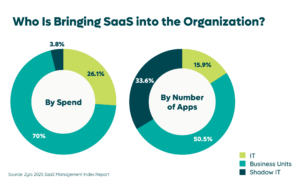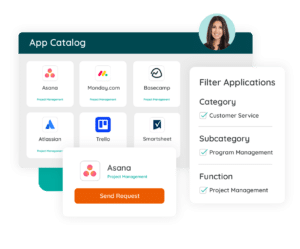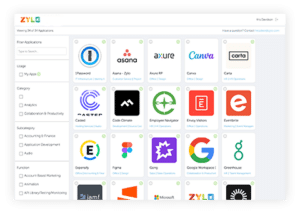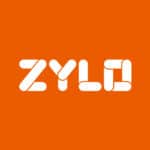
Zylo Wrapped 2025: SaaS Spend, AI Impact, and What’s Next
Table of Contents ToggleKey Themes That Shaped SaaS Management in 20251....
Back
Back
Search for Keywords...
Blog

09/01/2021
Table of Contents
SaaS usage is growing faster than a viral TikTok video. (OK, not quite. But it’s growing really, really fast, OK?)
Every 30 days, a typical company adds at least eight new applications to its environment—and three applications exit active use. That’s a lot of turnover and a lot of room for expensive confusion. It’s also partially why up to 12% of SaaS applications in a large organization are the result of a duplicate purchase.
Q: How can IT teams keep these numbers in check for their own organization?
A: With a SaaS sourcing optimization tool.
What, exactly, is an optimization tool for sourcing SaaS? It’s one of the descriptions we have for a SaaS Management Platform (SMP). These tools help you reduce the negative impact of shadow IT and employee-driven procurement, reduce security risks, and limit the number of strategic endeavors that get disrupted.
First up, a SaaS sourcing optimization tool will help you limit the chaos of employee driven procurement.
IT continues to own less SaaS spend and manage less of the organization’s apps. According to Zylo’s SaaS Management Index, IT now owns 26% of SaaS spend and 16% of apps. In turn, business units continue to own more SaaS spend. Individual lines of business now own 70% of SaaS spend and 51% of applications.

With direct control or at least visibility into this spend, SaaS sourcing is far from optimized.
This decentralized sourcing approach can lead to security risks, too. Shadow IT continues to grow both in terms of spend and quantity. This means employees are more likely to go and get the tools they need on their own—without IT being able to jump in and put the right procurement process in place or even require single sign-on (SSO) for security purposes.
In a phrase, Zylo’s App Catalog lets employees find out which tools are already being used in your organization and source their own tools with a curated, pre-vetted list of approved software specific to your business.
 The biggest challenge many companies face in software governance is creating visibility and transparency to what software is available to employees, and “get out of the way of them getting access to it,” so employees can quickly acquire the tools they need to effectively perform their work.
The biggest challenge many companies face in software governance is creating visibility and transparency to what software is available to employees, and “get out of the way of them getting access to it,” so employees can quickly acquire the tools they need to effectively perform their work.
Give users direct visibility into a curated selection of pre-vetted cloud software and SaaS applications and eliminate “Who owns what?” tool requests.
If an app is searched for but not found in the company’s App Catalog instance, apps present in the catalog with similar functionality will be recommended.
App Catalog provides a cost-effective and efficient way for new hires to not only gain access to basic tools required for their roles but also provides them the option to self-select tools that can help them be more productive in their work.
With a single source for approved SaaS applications, App Catalog gives employees the tools they need to do their jobs on day one.

With a one-stop-shop for business applications, users know who owns what and can learn more about how an application is used in their business so they can make informed requests for application access, reducing friction and time to value.
Admins are able to add information about each application they publish to the catalog, including any prerequisites or steps needed to gain access to an application, what roles can access specific applications, references to internal subject-matter experts, and links to web pages for best practices or how-to instructions for company-specific application use cases.
Within the App Catalog, employees can find info about an application they may need, including its categorization, designated function, whom to contact with questions about the app or to request access, and any other relevant details.
A SaaS optimization tool doesn’t just help you get organized with what you have in place already—it also sets you up for a more strategic, informed procurement approach across the organization.
Here are a few ideas to get you started:
Want to learn a bit more? Talk to us.
ABOUT THE AUTHOR

Zylo
Zylo is the leading enterprise SaaS management platform that transforms how companies manage and optimize the vast and accelerating number of cloud-based applications organizations rely on today. The platform provides one system of record for all cloud-based software purchased across a company, enabling customers to discover, manage, measure and optimize cloud investments with real-time insights into spend, utilization and feedback data.

Table of Contents ToggleKey Themes That Shaped SaaS Management in 20251....

Table of Contents ToggleWhy You Need a SaaS Sourcing Optimization ToolApplication...

Table of Contents ToggleWhy You Need a SaaS Sourcing Optimization ToolApplication...

Table of Contents ToggleWhy You Need a SaaS Sourcing Optimization ToolApplication...
| Cookie | Duration | Description |
|---|---|---|
| cookielawinfo-checkbox-analytics | 11 months | This cookie is set by GDPR Cookie Consent plugin. The cookie is used to store the user consent for the cookies in the category "Analytics". |
| cookielawinfo-checkbox-functional | 11 months | The cookie is set by GDPR cookie consent to record the user consent for the cookies in the category "Functional". |
| cookielawinfo-checkbox-necessary | 11 months | This cookie is set by GDPR Cookie Consent plugin. The cookies is used to store the user consent for the cookies in the category "Necessary". |
| cookielawinfo-checkbox-others | 11 months | This cookie is set by GDPR Cookie Consent plugin. The cookie is used to store the user consent for the cookies in the category "Other. |
| cookielawinfo-checkbox-performance | 11 months | This cookie is set by GDPR Cookie Consent plugin. The cookie is used to store the user consent for the cookies in the category "Performance". |
| viewed_cookie_policy | 11 months | The cookie is set by the GDPR Cookie Consent plugin and is used to store whether or not user has consented to the use of cookies. It does not store any personal data. |
